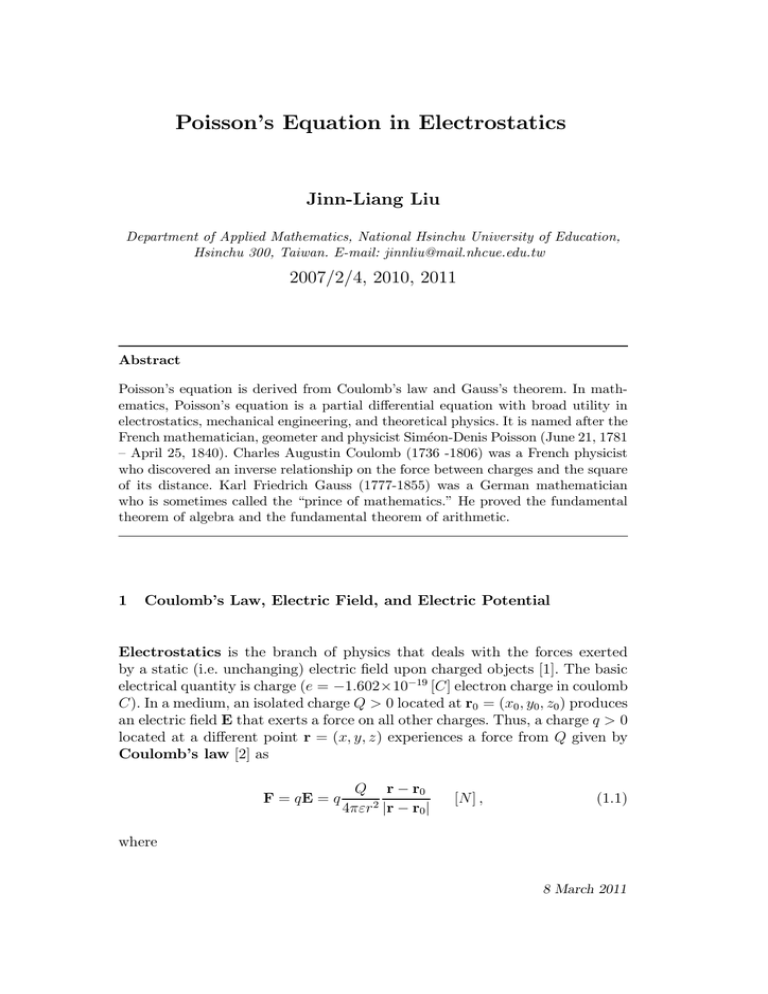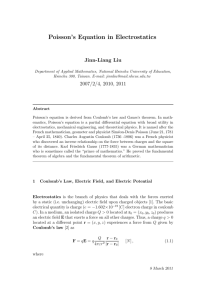Poisson’s Equation in Electrostatics Jinn-Liang Liu
advertisement

Poisson’s Equation in Electrostatics
Jinn-Liang Liu
Department of Applied Mathematics, National Hsinchu University of Education,
Hsinchu 300, Taiwan. E-mail: jinnliu@mail.nhcue.edu.tw
2007/2/4, 2010, 2011
Abstract
Poisson’s equation is derived from Coulomb’s law and Gauss’s theorem. In mathematics, Poisson’s equation is a partial differential equation with broad utility in
electrostatics, mechanical engineering, and theoretical physics. It is named after the
French mathematician, geometer and physicist Siméon-Denis Poisson (June 21, 1781
— April 25, 1840). Charles Augustin Coulomb (1736 -1806) was a French physicist
who discovered an inverse relationship on the force between charges and the square
of its distance. Karl Friedrich Gauss (1777-1855) was a German mathematician
who is sometimes called the “prince of mathematics.” He proved the fundamental
theorem of algebra and the fundamental theorem of arithmetic.
1
Coulomb’s Law, Electric Field, and Electric Potential
Electrostatics is the branch of physics that deals with the forces exerted
by a static (i.e. unchanging) electric field upon charged objects [1]. The basic
electrical quantity is charge (e = −1.602×10−19 [C] electron charge in coulomb
C). In a medium, an isolated charge Q > 0 located at r0 = (x0 , y0 , z0 ) produces
an electric field E that exerts a force on all other charges. Thus, a charge q > 0
located at a different point r = (x, y, z) experiences a force from Q given by
Coulomb’s law [2] as
F = qE = q
Q r − r0
4πεr2 |r − r0 |
[N] ,
(1.1)
where
8 March 2011
[N ] represents the unit of the force in newton,
r = |r − r0 | , and
ε = permittivity (or dielectric constant) [F/L] of the medium,
F : farads [F = C/V ] .
A dimension defines some physical characteristics. For example, length [L],
mass [M ], time [T ], velocity [L/T ], and force [N = M L/T 2 ]. A unit is a standard or reference by which a dimension can be expressed numerically. In SI
(the International System of Units or in the French name Systeme Internationale d’Unites), the meter [m], kilogram [kg], second [s], ampere [A], kelvin
[K], and candela [cd] are the base units for the six fundamental dimensions of
length, mass, time, electric current, temperature, and luminous intensity [3].
The electric permittivity ε is conventionally expressed as
ε = εr ε0 ,
εr = the dielectric constant or relative electric permittivity,
ε0 = permittivity of vacuum = 8.85 × 10−12 [F/L] .
For air at atmospheric pressure εr = εAir = 1.0006. Other dielectric constants
εW ater = 80, εSi = 11.68, εInAs = 14.55, εGaAs = 13.13.
The electric field E(r) (a force per unit charge) produced by Q at r0 and
felt by the unit charge at r is thus defined by
E(r) =
Q r − r0
4πεr2 |r − r0 |
[N/C] .
(1.2)
By moving a charge q against the field between the two points a and b with a
distance ∆x, work is done. That is, for 1D case,
F ∆x = qE∆x
∆Φ : = E∆x =
!
force
work
× distance =
charge
charge
"
J
V = , V = volt, J = N L joule .
C
(1.3)
This work per charge defines the electric potential difference ∆Φ between
the points a and b. Here the Greek letter delta ∆ means a difference. This
symbol will also be used in another meaning for the Laplace operator below.
2
Potential energy exists whenever an object which has charge (or mass) and has
a position within an electric (or gravitational) field. Equivalently, the electric
field can be defined by the potential as
∆Φ
Φ(x + ∆x) − Φ(x)
dΦ (x)
= − lim
=−
∆x→0
∆x
∆x
dx
E(r) = − grad Φ(r) = −∇Φ(r) [in 2D or 3D]
#
$
∂ ∂ ∂
=−
, ,
Φ(r).
∂x ∂y ∂z
E (x) = −
[in 1D]
(1.4)
The negative sign above reminds us that moving against the electric field
results in positive work. The electric potential Φ(r) is therefore a scalar
function of r and is the (positive) work per unit charge that we must pay for
moving the unit charge from infinity to the position r within the electric field
generated by Q.
2
Gauss’s Theorem
Gauss’s Theorem is a 3D generalization from the Fundamental Theorem of
Calculus in 1D. The following theorems can be found in standard Calculus
books.
Theorem 1 (Fundamental Theorem of Calculus) If f is a differentiable
function on [a, b], then
%
b
a
f ′ (x)dx = f (b) − f(a).
(2.1)
Line Integral (1D) = Point Evaluation (0D)
Theorem 2 (Divergence Theorem of Gauss (1832)) Let B be an open
bounded domain in R3 with a piecewise smooth boundary ∂B. Let u(x, y, z) be
a differentiable vector function in B. Then
%%%
B
div udr =
%%%
B
∇ · udr =
%%
∂B
u · ndS
(2.2)
Domain Integral (3D) = Boundary Integral (2D)
Total Mass Change in B = Mass Flows across ∂B,
where n is an outward unit normal vector on ∂B. The integral
also called the flux u across the surface S.
3
&&
∂B
u · ndS is
Theorem 3 (Mean Value Theorem (MVT)) If f is continuous on [a, b],
then there exists a number c ∈ [a, b] such that
%
b
f (x)dx = f (c)
a
3
%
b
a
dx = f (c) (b − a) .
(2.3)
Poisson’s Equation
Assume that the electric field E(r) is differentiable in its domain Ω ⊂ R3 . To
simplify our presentation of using Gauss’s theorem, we consider any subset
B ⊂ Ω as a ball with radius r centered at r0 , i.e., B = {r ∈ Ω : |r − r0 | < r}
whose boundary ∂B is a sphere. The following argument can be generalized
to any closed bounded domain as required by Causs’s theorem with, of course,
more technicalities [2]. We may think for the moment that the variable r0 is
“fixed.” Applying (2.2) to the electric field in (1.4), we have
lim
r→0
%%%
B
%%%
∇ · εE(r)dr = − lim
r→0
B
∇ · ε∇Φ(r)dr
!
= −∇ · ε∇Φ(r0 ) lim
r→0
'
%%%
= lim
r→0
%%
∂B
dr by MVT
B
(
3
4πr
r→0 3
= −∇ · ε∇Φ(r0 ) lim
εE(r) · ndS.
(3.1)
"
(3.2)
(3.3)
(3.4)
Eq. (3.2) is valid if ∇ · ε∇Φ(r) is continuous on B. Since B is infinitesimally
small, the existing point guaranteed by MVT is nothing but r0 as r → 0.
The surface integral
ψ=
%%
∂B
εE · ndS
[C]
(3.5)
is called the electric flux of E through the sphere ∂B. We can imagine the
flux ψ as the sum (total charge) of infinitely many small charges that have
been “flowing” through infinitesimal surfaces dS (note the unit in Coulomb).
Note also that (1.2) gives us a hint that
ψ = 4πr2 × εE = Q
(3.6)
is the total charge Q passing through the sphere ∂B. There are several situations we need to be more specific about the limiting flux in (3.4).
Case 1. No charges within B and Ω at all.
4
Nothing is passing through the sphere ∂B. Before taking the limit in both
(3.3) and (3.4), we have zero for (3.4) which implies that
−∇ · ε∇Φ(r0 ) = 0 for all r0 ∈ Ω
(3.7)
provided that any ball containing r0 does not have any charge in it. Let us assume for the moment that the domain Ω contains nothing and the permittivity
is constant. We then have the Laplace equation
∆Φ(r) = 0 for all r ∈ Ω,
2
2
(3.8)
2
∂
∂
∂
where ∆ = ∇ · ∇ = ∂x
2 + ∂y 2 + ∂z 2 is the Laplace operator. One may wonder
that the solution of (3.8) is identically zero. Yes or no, it depends on the
boundary condition of (3.8). Note carefully that we apply Gauss’s theorem for
an open domain Ω and say nothing about the charges on the boundary ∂Ω.
This is one of examples that we must be very rigorous on the precise statement
of mathematical definitions and theorems. In general, the Laplace problem
can be stated as to find a solution (potential) Φ such that
∆Φ(r) = 0,
∀ r ∈ Ω,
Φ(r) = ΦD (r),
∀ r ∈ ∂ΩD ,
∂Φ(r)
= ΦN (r),
∀ r ∈ ∂ΩN ,
∂n
(3.9a)
(3.9b)
(3.9c)
where ∂Ω = ∂ΩD ∪ ∂ΩN , ΦD and ΦN are given functions. (3.9b) is usually
called a Dirichlet (or essential) boundary condition whereas (3.9c) called a
Neumann (or natural) boundary condition. Here ∂Φ(r)
= ∇Φ(r) · n is a direc∂n
tional derivative with the direction of the outward normal unit n to ∂ΩN at
r.
Case 2. B contains a single charge Q0 at r0 and Ω contains finitely many
charges Qi at ri , i = 1, · · · n.
From (3.3) and (3.4), we have
'
(
4πr3
−∇ · ε∇Φ(r0 ) lim
= lim Q0 = Q0
r→0 3
r→0
which yields a very strange equation
−∇ · ε∇Φ(r0 ) =
The term
Q0
3
limr→0 4πr
3
Q0
limr→0
4πr3
3
(3.10)
has no physical meaning and can only be abstracted math-
ematically by means of the Dirac delta function [1] (a distribution as called
5
by mathematicians)
∞, r = r0
δ(r − r0 ) =
0, r ̸= r
0
%
;
R3
δ(r − r0 )dr = 1.
(3.11)
For any continuous function Q(r), the delta function has the fundamental
property that
%
Q(r)δ(r − r0 )dr = Q(r0 )
(3.12)
R3
3
Since the volume limr→0 4πr
is infinitely small, we can write limr→0
3
and define ρ(r) as a continuous function such that
ρ(r) =
Q0 - −3 .
CL
dr
4πr3
3
= dr
(3.13)
This function is thus called a charge density function. This is not a mathematically perfect way to define the density function for a point charge because
the volume dr is not definite. A more general definition for all kinds of charges
including the point charge is the following. We define the density function for
a point charge Q0 at r0 by means of delta function as
ρ(r) =Q0 δ(r − r0 )
(3.14)
By (3.12), we thus have
%
R3
ρ(r)dr =
%
R3
Q0 δ(r − r0 )dr =Q0
(3.15)
Consequently, we have the following Poisson equation for a point charge
−∇ · ε∇Φ(r) = Q0 δ(r − r0 )
(3.16)
It should be noticed that the delta function in this equation implicitly defines
the density which is important to correctly interpret the equation in actual
physical quantities.
If the domain Ω contains isolated charges Qi at ri , i = 1, 2, · · · , n, the Poisson
equation becomes
−∇ · ε∇Φ(r) =
n
/
i=1
Qi δ(r − ri )
(3.17)
Case 3. Both B and Ω contain infinitely many charges expressed by a density
function ρ(r).
6
It is clear now that the total flux charges of (3.5) “flowing” through the sphere
∂B is equal to the total charges residing in the open ball B, i.e., by (3.1), (3.4),
and (3.5)
ψ=
%%
∂B
εE · ndS =
%%%
B
ρ(r)dr = −
%%%
B
∇ · ε∇Φ(r)dr
(3.18)
These equalities hold for any arbitrary domain B. The last equality therefore
implies the Poisson problem
−∇ · ε∇Φ(r) = ρ(r),
Φ(r) = ΦD (r),
ε∂Φ(r)
= ΦN (r),
∂n
∀ r ∈ Ω,
∀ r ∈ ∂ΩD ,
(3.19a)
(3.19b)
∀ r ∈ ∂ΩN .
(3.19c)
References
[1] Wikipedia: The Free Encyclopedia, http://en.wikipedia.org/wiki/Electrostatics
[2] J. D. Jackson, Classical Electrodynamics, 3rd ed., Wiley, 1999.
[3] J. D. Kraus and D. A. Fleisch, Electromagnetics with Applications, 5th ed.,
McGraw-Hill, 1999.
7





